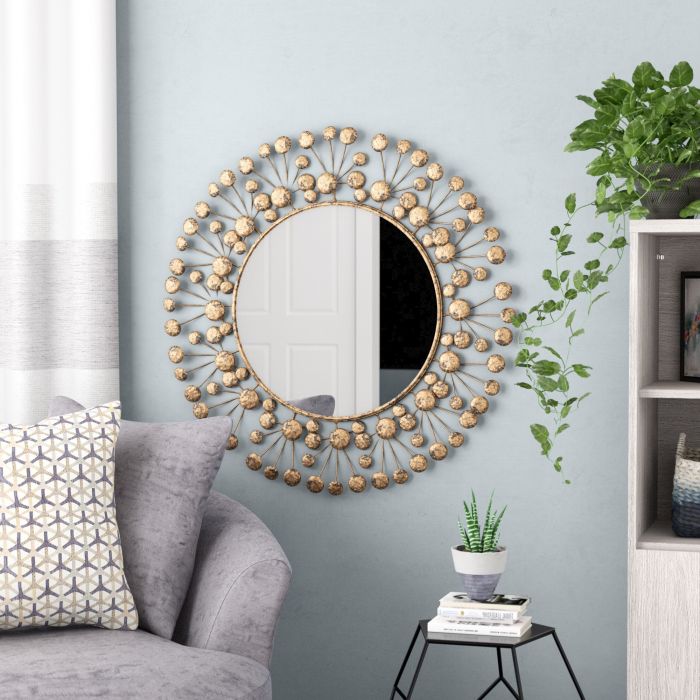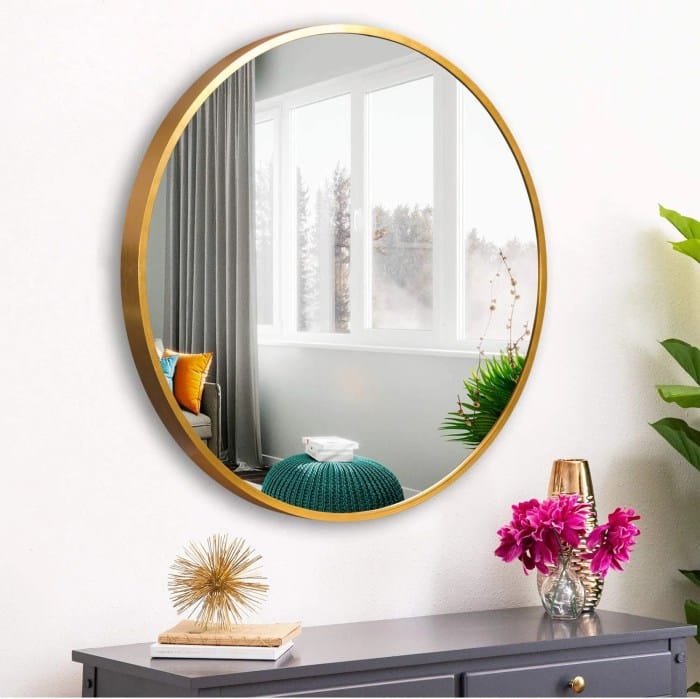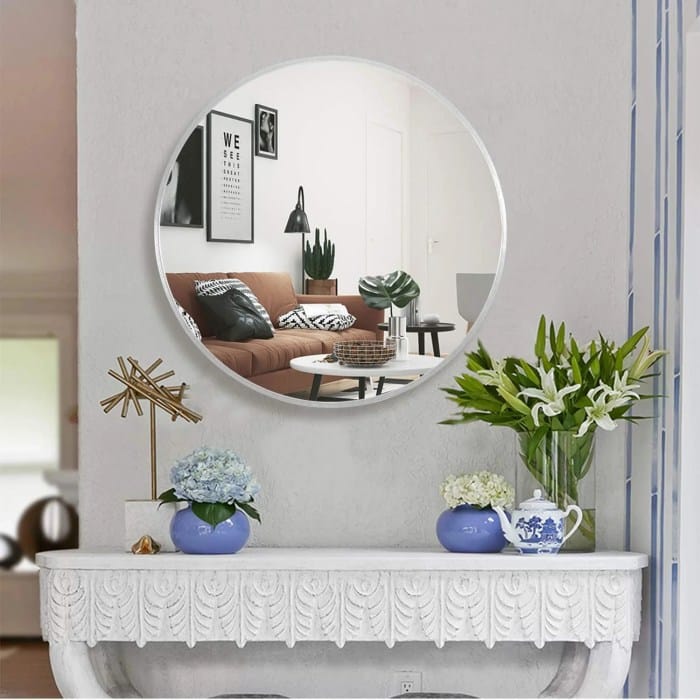Wall mirrors, more than just reflective surfaces, play a pivotal role in shaping the ambiance and functionality of any space. From classic framed designs to modern minimalist styles, wall mirrors offer a wide array of options to complement diverse aesthetics and architectural features.
Their ability to create illusions of space, amplify natural light, and serve as captivating focal points makes them an indispensable element in interior design.
Beyond their decorative appeal, wall mirrors serve practical purposes. They can visually enlarge a room, enhance natural light, and create a sense of depth and dimension.
Whether used to accentuate a piece of artwork, create a sense of symmetry, or simply add a touch of elegance, wall mirrors possess the power to transform the look and feel of any environment.
Types of Wall Mirrors
Wall mirrors are essential decorative elements that enhance the visual appeal of any space. They reflect light, creating a sense of spaciousness and adding depth to the room. Mirrors come in a wide array of styles, materials, and functionalities, catering to diverse tastes and design preferences.
Materials and Styles
The materials and styles of wall mirrors significantly influence their aesthetic appeal and functionality.
- Framed Mirrors: Framed mirrors are a classic choice, offering a sophisticated and timeless look. Frames are typically made from wood, metal, or plastic, and can be ornate, minimalist, or contemporary in style. The frame enhances the mirror’s visual impact and provides a decorative element to the space.
- Unframed Mirrors: Unframed mirrors are characterized by their clean and modern aesthetic. They feature a sleek, minimalist design, emphasizing the reflection itself. Unframed mirrors are often made from glass with polished edges, creating a seamless and contemporary look.
- Antique Mirrors: Antique mirrors possess a unique charm and historical significance. They often feature intricate carvings, distressed finishes, and aged glass, adding a touch of vintage elegance to the space. Antique mirrors are highly sought after for their character and historical value.
- Modern Mirrors: Modern mirrors embrace contemporary design principles, featuring clean lines, geometric shapes, and innovative materials. They can be made from a variety of materials, including metal, acrylic, and glass, and often incorporate unique features like LED lighting or textured surfaces.
Uses of Wall Mirrors

Wall mirrors are versatile decorative elements that serve a variety of purposes in homes, offices, and public spaces. They can enhance the aesthetics of a room by creating illusions of space, adding depth, and reflecting light.
Creating Illusions of Space
Mirrors can create the illusion of a larger space by reflecting the existing surroundings, making the room appear more expansive.
This is particularly beneficial in smaller rooms or areas with limited natural light. For example, placing a large mirror opposite a window can reflect the outdoor scenery, effectively doubling the view and bringing in more natural light.
Mirrors can create the illusion of a larger space by reflecting the existing surroundings, making the room appear more expansive.
This is particularly beneficial in smaller rooms or areas with limited natural light. For example, placing a large mirror opposite a window can reflect the outdoor scenery, effectively doubling the view and bringing in more natural light.
Creating Illusions of Space with mirrors is a practical and stylish way to enhance any room. Strategically placed mirrors can make smaller spaces feel more open by reflecting light and the surrounding environment.
For example, positioning a large mirror opposite a window can amplify natural light and extend the view, creating an airy and spacious ambiance. This technique is especially effective in compact rooms or areas with limited natural lighting.
For homeowners seeking space-enhancing design tips or decor ideas for small rooms, mirrors offer a versatile and elegant solution.
Adding Depth and Dimension
Mirrors can add depth and dimension to a room by reflecting light and creating visual interest. Placing a mirror on a wall opposite a window can create a sense of depth, making the room feel larger and more inviting. Mirrors can also be used to create a focal point, drawing the eye to a particular area of the room.
Enhancing Ambiance
Mirrors can enhance the overall ambiance of a space by reflecting light and creating a sense of warmth and openness. They can also be used to create a more dramatic or sophisticated look, depending on the style of the mirror and the surrounding decor. For example, a large, ornate mirror can add a touch of elegance to a living room, while a simple, modern mirror can create a minimalist aesthetic in a bedroom.
Defining Areas
Mirrors can be used to define areas within a larger space, such as a living room or a bedroom. For example, a large mirror can be placed behind a sofa to create a distinct seating area, while a smaller mirror can be used to define a dressing area in a bedroom.
Creating Focal Points, Wall Mirrors
Mirrors can be used to create focal points in a room, drawing the eye to a particular area. For example, a large mirror placed above a fireplace can create a dramatic focal point, while a smaller mirror placed above a console table can create a more subtle focal point.
Wall Mirror Styles
Wall mirrors are not just functional, they are also an integral part of interior design. They can transform a space, adding depth, light, and personality. The style of a wall mirror can greatly influence the overall aesthetic of a room, reflecting the homeowner’s taste and design preferences.
Traditional Wall Mirror Styles
Traditional wall mirror styles are characterized by classic designs, often drawing inspiration from historical periods. They typically feature intricate details, ornate frames, and timeless shapes.
- Victorian: Victorian wall mirrors are known for their elaborate, often gilded frames, featuring floral motifs, scrolls, and intricate carvings. They often have a rectangular or oval shape and are commonly seen in antique shops and vintage homes.
- Rococo: Rococo mirrors are characterized by their asymmetrical, flowing lines and elaborate ornamentation. They often feature shell-like shapes, floral motifs, and delicate carvings. Rococo mirrors are known for their elegance and sophistication, adding a touch of grandeur to any room.
- Art Deco: Art Deco mirrors are defined by their geometric patterns, bold lines, and use of luxurious materials like polished brass, silver, or ebony. They often feature geometric shapes, such as circles, squares, and triangles, and can be either minimalist or extravagant in their design.
Contemporary Wall Mirror Styles
Contemporary wall mirror styles are characterized by their clean lines, simple forms, and modern materials. They often feature minimalist designs and a focus on functionality.
- Minimalist: Minimalist wall mirrors are characterized by their simple, uncluttered designs. They often feature thin, unadorned frames or no frames at all, and are typically rectangular or square in shape. Minimalist mirrors are ideal for creating a sense of calm and order in a room.
- Industrial: Industrial wall mirrors are characterized by their use of raw materials, such as metal, wood, and glass. They often feature distressed finishes, exposed hardware, and a utilitarian aesthetic. Industrial mirrors are perfect for adding a touch of edgy coolness to a space.
- Mid-Century Modern: Mid-Century Modern wall mirrors are characterized by their simple, geometric shapes, clean lines, and use of natural materials. They often feature wood frames, brass accents, and a focus on functionality. Mid-Century Modern mirrors are ideal for creating a sense of sophistication and elegance in a room.
Eclectic Wall Mirror Styles
Eclectic wall mirror styles are characterized by their unique and often unexpected combinations of elements. They often blend different styles, materials, and design features to create a one-of-a-kind look.
- Bohemian: Bohemian wall mirrors are characterized by their use of natural materials, such as wood, rattan, and bamboo. They often feature intricate details, colorful patterns, and a bohemian aesthetic. Bohemian mirrors are perfect for adding a touch of whimsy and personality to a room.
- Global: Global wall mirrors are inspired by different cultures and styles from around the world. They often feature intricate carvings, vibrant colors, and unique materials. Global mirrors are ideal for adding a touch of exoticism and sophistication to a room.
- Rustic: Rustic wall mirrors are characterized by their use of natural materials, such as wood, stone, and metal. They often feature distressed finishes, rough textures, and a simple, unpretentious aesthetic. Rustic mirrors are perfect for adding a touch of warmth and charm to a room.
Wall Mirror Styles: A Comparison
| Style | Materials | Finishes | Design Features |
|---|---|---|---|
| Traditional | Wood, metal, glass | Gilded, painted, carved | Intricate details, ornate frames, classic shapes |
| Contemporary | Metal, glass, acrylic | Polished, brushed, distressed | Clean lines, simple forms, modern materials |
| Eclectic | Various materials | Various finishes | Unique combinations of elements, mixed styles |
Placement and Integration

Strategic placement of wall mirrors can significantly enhance the visual appeal and functionality of a space. By carefully considering the size, shape, and style of the mirror in relation to the surrounding furniture and decor, you can create a sense of balance, symmetry, or asymmetry that complements the overall design aesthetic.
Placement Strategies
Mirrors can be used to visually expand a space, reflect light, and create a sense of depth. Here are some strategies for placing wall mirrors effectively:
- To create the illusion of space: Place a large mirror opposite a window to reflect natural light and make the room appear larger.
- To enhance natural light: Position a mirror to reflect light from a window or other light source into a darker corner of the room.
- To draw attention to a focal point: Place a mirror behind or beside a statement piece of furniture, artwork, or architectural feature to highlight it.
- To create a sense of balance: Use a pair of matching mirrors to balance a room’s visual weight, such as flanking a fireplace or a sofa.
- To add visual interest: Hang a series of mirrors of varying sizes and shapes to create a dynamic and eclectic display.
Mirror Size and Shape
The size and shape of a mirror should be carefully considered in relation to the surrounding furniture and decor.
- Small mirrors are ideal for adding subtle accents and reflecting light in smaller spaces.
- Large mirrors can create a dramatic focal point and make a room feel more spacious.
- Rectangular mirrors are versatile and can be used in a variety of settings.
- Round mirrors add a touch of elegance and can soften the edges of a room.
- Oval mirrors offer a more traditional look and can be used to create a sense of symmetry.
Mirror Style
The style of a mirror should complement the overall design aesthetic of the room.
- Modern mirrors often feature clean lines and minimalist designs.
- Traditional mirrors may have ornate frames and intricate details.
- Rustic mirrors can add a touch of warmth and charm to a space.
- Contemporary mirrors often feature unique shapes and materials.
Creating Balance and Symmetry
Mirrors can be used to create a sense of balance and symmetry in a room.
Wall mirrors are a versatile design element that can instantly transform a space. They can make a room feel larger, brighter, and more inviting. When considering the overall aesthetic of a room, it’s important to think about the furniture as well. For instance, the style of your Dining Chairs can complement the reflective qualities of your wall mirrors, creating a cohesive and stylish look.
- Symmetrical placement involves placing two identical mirrors on opposite sides of a focal point, such as a fireplace or a sofa. This creates a sense of order and harmony.
- Asymmetrical placement involves using mirrors of different sizes and shapes to create a more dynamic and eclectic look. This can add visual interest and prevent the room from feeling too formal.
Decorative Aspects

Wall mirrors are more than just functional pieces; they are powerful decorative elements that can transform the aesthetic of any space. They possess the unique ability to amplify light, create illusions of space, and add a touch of elegance and sophistication.
Enhancing the Decorative Appeal
Wall mirrors play a crucial role in enhancing the decorative appeal of a space by manipulating light and creating visual interest. They can be used to:* Amplify Natural Light: Mirrors reflect natural light, making rooms appear brighter and more inviting. This is particularly beneficial in spaces with limited natural light, such as hallways or bathrooms.
Create the Illusion of Space
By reflecting the surrounding environment, mirrors can make small spaces feel larger and more open. They can also be used to create a sense of depth and dimension, particularly in rooms with limited floor space.
Add a Touch of Glamour
Mirrors, especially those with ornate frames, can add a touch of glamour and sophistication to a space. They can elevate the overall aesthetic and create a more luxurious ambiance.
Showcasing Artwork
Wall mirrors can be strategically placed to enhance the display of artwork. They can be used to:* Reflect and Amplify the Artwork: By placing a mirror opposite or near a piece of artwork, you can create a visual dialogue between the two elements. The mirror will reflect the artwork, creating a sense of depth and drawing attention to it.
Create a Focal Point
Mirrors can be used to create a focal point in a room by drawing the eye to a specific area. This is particularly effective when placed above a piece of artwork or a collection of objects.
Enhance the Visual Interest of the Artwork
Mirrors can be used to create a sense of movement and energy in a space by reflecting the artwork and creating multiple perspectives.
Accentuating Architectural Features
Mirrors can be used to accentuate architectural features, creating a more dynamic and visually appealing space. This can be achieved by:* Highlighting Architectural Details: Mirrors can be used to highlight architectural details such as moldings, cornices, or fireplaces. By reflecting these features, mirrors can draw attention to them and enhance their visual impact.
Creating a Sense of Symmetry
Mirrors can be used to create a sense of symmetry in a room by reflecting existing architectural features. This can create a more balanced and harmonious aesthetic.
Expanding the Visual Perception of Space
Mirrors can be used to create the illusion of larger or more expansive spaces by reflecting architectural features such as doorways or windows.
Creating a Cohesive Design Theme
Mirrors can be used to create a cohesive design theme by:* Reflecting the Color Palette: Mirrors can reflect the color palette of a room, creating a sense of continuity and harmony. This can be achieved by using mirrors with frames that complement the existing colors in the space.
Matching the Style of the Furniture
Mirrors can be used to complement the style of the furniture in a room. For example, a traditional mirror would be a good choice for a room with antique furniture, while a modern mirror would be a good choice for a room with contemporary furniture.
Creating a Sense of Unity
Mirrors can be used to create a sense of unity in a room by reflecting the different elements of the design. This can create a more cohesive and harmonious aesthetic.
Tips for Using Wall Mirrors
Here are some tips for using wall mirrors to create a visually appealing and functional space:
- Consider the Size and Shape: The size and shape of the mirror should be appropriate for the space and the style of the room. A large mirror can make a small room feel larger, while a small mirror can add a touch of elegance to a large room.
- Choose the Right Frame: The frame of the mirror can have a significant impact on the overall aesthetic of the room. Choose a frame that complements the style of the room and the other furniture and décor.
- Place Mirrors Strategically: Mirrors can be used to create a variety of effects, depending on their placement. For example, placing a mirror opposite a window can amplify natural light, while placing a mirror above a fireplace can create a focal point.
- Use Mirrors to Create a Sense of Depth: Mirrors can be used to create the illusion of depth in a room by reflecting the surrounding environment. This can be particularly effective in small rooms or rooms with limited floor space.
- Avoid Overusing Mirrors: While mirrors can be a powerful decorative tool, it’s important to avoid overusing them. Too many mirrors can make a room feel cluttered and overwhelming.
Wall Mirror Maintenance
Maintaining the pristine condition of your wall mirrors is crucial for preserving their aesthetic appeal and functionality. Regular cleaning and addressing any issues promptly can ensure that your mirrors continue to reflect light beautifully and serve their purpose effectively.
Cleaning and Maintaining Wall Mirrors
Regular cleaning is essential for maintaining the clarity and shine of your wall mirrors. Here are the recommended steps for cleaning wall mirrors:
- Gather your supplies: You will need a microfiber cloth, a spray bottle, distilled water, white vinegar, and a soft-bristled brush.
- Prepare the cleaning solution: In your spray bottle, mix equal parts distilled water and white vinegar. This solution is effective at removing dirt, grime, and fingerprints without leaving streaks.
- Spray the mirror: Lightly mist the mirror surface with the cleaning solution, ensuring even coverage.
- Wipe the mirror: Using a clean microfiber cloth, gently wipe the mirror surface in a circular motion, starting from the top and working your way down.
- Dry the mirror: Use a dry microfiber cloth to thoroughly dry the mirror surface, removing any excess moisture.
- Polish the mirror: For an extra shine, you can use a specialized mirror polish. Apply a small amount to a clean microfiber cloth and gently buff the mirror surface.
Addressing Common Problems
While regular cleaning helps prevent most issues, certain problems may arise with wall mirrors. Here’s how to address them:
- Scratches: Scratches on mirror surfaces can be challenging to remove completely. However, you can attempt to minimize their visibility using a specialized glass polish or a fine-grit sandpaper. Apply the polish or sandpaper gently in a circular motion, working from the center of the scratch outward.
- Smudges and fingerprints: These can be easily removed using the cleaning solution mentioned earlier. Spray the affected area, wipe with a microfiber cloth, and dry thoroughly.
- Water damage: Water damage can cause streaks and spots on the mirror surface. To address this, use a dry microfiber cloth to absorb excess moisture. If the streaks persist, apply the cleaning solution and wipe gently.
Recommended Cleaning Products and Tools
To effectively maintain your wall mirrors, consider using the following cleaning products and tools:
- Microfiber cloths: These cloths are highly absorbent and lint-free, making them ideal for cleaning mirrors without leaving streaks.
- Distilled water: This type of water is free of impurities that can leave streaks or spots on the mirror surface.
- White vinegar: A natural cleaning agent that effectively removes dirt, grime, and fingerprints.
- Soft-bristled brush: This can be used to remove dust and debris from the mirror frame and surrounding areas.
- Specialized glass polish: This type of polish can help restore the shine and clarity of your mirrors.
- Fine-grit sandpaper: This can be used to attempt to minimize the visibility of scratches.
Wall mirrors are more than just reflective surfaces; they are versatile design elements that can elevate the aesthetics and functionality of any space. By carefully considering the type, style, and placement of a wall mirror, you can create a visually appealing and harmonious environment that reflects your unique taste and personality. Whether you’re seeking to enhance the ambiance of your home, office, or public space, wall mirrors offer a timeless and transformative solution.
Query Resolution
What are some common types of wall mirrors?
Common types of wall mirrors include framed, unframed, antique, and modern mirrors. Each type offers distinct aesthetics and functionalities, catering to various design preferences.
How do I choose the right size and shape for my wall mirror?
The ideal size and shape of a wall mirror depend on the dimensions of the space, the surrounding furniture, and the desired aesthetic. Consider the proportions of the room and choose a mirror that complements the existing decor.
What are some tips for cleaning and maintaining wall mirrors?
To maintain the shine and clarity of your wall mirror, use a microfiber cloth and a mild cleaning solution. Avoid abrasive cleaners that can damage the surface. Regular dusting and cleaning will help prevent smudges and streaks.




